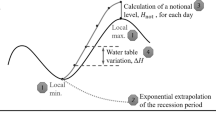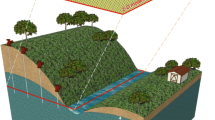Abstract
Accurate evaluation of natural recharge is fundamental for the estimation of renewable groundwater resources and constitutes a key issue for water resources management. Among physical, chemical and numerical methods, the water-table fluctuation technique is simple and easy to use. The main question is where, with respect to the draining stream, to locate the monitoring well to effectively observe representative water level fluctuations. Storage and discharged volumes in an unconfined aquifer during the water-table fluctuation application are described with equations using the Dupuit-Forchheimer model. This leads to the determination of an optimal distance from the stream (0.4 times the length of the aquifer) for siting observation wells. Beyond this distance, the computed volumes stored in the aquifer are overestimated by up to 20%. Less than this distance, the stored volume is highly underestimated.
Résumé
L’évaluation précise de la recharge naturelle des aquifères est fondamentale pour l’estimation des ressources en eau souterraine renouvelables et constitue un élément clé de la gestion intégrée des ressources en eau. Parmi les méthodes physiques, chimiques et numériques, la technique de la fluctuation du niveau de la nappe aquifère est simple et facile à utiliser. La question principale reste cependant où, par rapport au cours d’eau drainant l’aquifère, localiser le piézomètre pour mesurer des fluctuations de niveau représentatives de la nappe. Les volumes d’eau stockés et drainés par un aquifère libre lors de l’application de la technique de fluctuation de la nappe sont décrits par des équations au moyen du modèle de Dupuit-Forchheimer. Cela permet de déterminer une distance optimale au cours d’eau (0.4 fois la longueur de l’aquifère) pour positionner idéalement des piézomètres. Au-delà de cette distance, les volumes de stockage dans l’aquifère calculés sont surestimés jusqu’à 20%. En-deçà de cette distance, les volumes stockés sont fortement sous-estimés.
Resumen
La evaluación correcta de la recarga natural es fundamental para la estimación de los recursos renovables de aguas subterráneas y constituye una cuestión clave para la gestión de los recursos hídricos. Entre los métodos físicos, químicos y numéricos, la técnica de fluctuación del nivel freático es sencilla y fácil de utilizar. La cuestión principal es dónde, con respecto a la corriente que drena, situar el pozo de monitoreo para observar eficazmente las fluctuaciones representativas del nivel del agua. Los volúmenes de almacenamiento y descarga en un acuífero no confinado durante la aplicación de la fluctuación del nivel freático se describen con ecuaciones que utilizan el modelo Dupuit-Forchheimer. De este modo, se determina una distancia óptima del curso de agua (0.4 veces la longitud del acuífero) para situar los pozos de observación. Más allá de esta distancia, los volúmenes calculados almacenados en el acuífero se sobreestiman hasta un 20%. Por debajo de esta distancia, el volumen almacenado está muy subestimado.
摘要
准确评估天然补给是估算可利用地下水资源和水资源管理的关键问题。在物理、化学和数值方法中,水位波动技术简单易用。主要问题是在何处相对于排泄式河流,放置监测井以有效观测代表性的水位波动。在水位波动应用期间,通过使用Dupuit-Forchheimer模型的方程描述了潜水含水层中的储存和排泄体积。这导致了确定距离河流的最佳距离(含水层长度的0.4倍)以确定观测井的位置。超过这个距离,储存在含水层中的计算体积被高估了多达20%。小于这个距离,则储存体积被严重低估。
Resumo
A avaliação precisa da recarga natural é fundamental para a estimativa dos recursos hídricos subterrâneos renováveis e constitui uma questão chave para a gestão dos recursos hídricos. Entre os métodos físicos, químicos e numéricos, a técnica de flutuação do nível freático é simples e fácil de usar. A principal questão é onde, em relação ao curso d’água, alocar o poço de monitoramento para efetivamente observar flutuações representativas do nível de água. Os volumes armazenados e descarregados em um aquífero não confinado durante a aplicação da flutuação do nível freático são descritos com equações usando o modelo de Dupuit-Forchheimer. Isso leva à determinação de uma distância ideal do córrego (0.4 vezes o comprimento do aquífero) para alocar os poços de monitoramento. Além dessa distância, os volumes computados armazenados no aquífero são superestimados em até 20%. Abaixo dessa distância, o volume armazenado é altamente subestimado.



Similar content being viewed by others
References
Ala-Aho P, Rossi PM, Kløve B (2015) Estimation of temporal and spatial variations in groundwater recharge in unconfined sand aquifers using Scots pine inventories. Hydrol Earth Syst Sci 19:1961–1976. https://doi.org/10.5194/HESS-19-1961-2015
Chemingui A, Sulis M, Paniconi C (2015) An assessment of recharge estimates from stream and well data and from a coupled surface-water/groundwater model for the des Anglais catchment, Quebec (Canada). Hydrogeol J 23:1731–1743. https://doi.org/10.1007/s10040-015-1299-1
Cuthbert MO (2010) An improved time series approach for estimating groundwater recharge from groundwater level fluctuations. Water Resour Res 46:9515. https://doi.org/10.1029/2009WR008572
Erskine AD, Papaioannou A (1997) The use of aquifer response rate in the assessment of groundwater resources. J Hydrol 202:373–391. https://doi.org/10.1016/S0022-1694(97)00058-9
Healy RW, Cook PG (2002) Using groundwater levels to estimate recharge. Hydrogeol J 10:91–109. https://doi.org/10.1007/s10040-001-0178-0
Jassas H, Merkel B (2014) Estimating groundwater recharge in the semiarid Al-Khazir Gomal Basin, North Iraq. Water 6:2467–2481. https://doi.org/10.3390/W6082467
Labrecque G, Chesnaux R, Boucher MA (2020) Water-table fluctuation method for assessing aquifer recharge: application to Canadian aquifers and comparison with other methods. Hydrogeol J 28:521–533. https://doi.org/10.1007/s10040-019-02073-1
Lanini S, Caballero Y (2021) ESPERE: a tool for multimethod aquifer recharge estimation: what’s new with version 2? Groundwater 59:5–6
Lanini S, Caballero Y, Seguin J-J, Maréchal J-C (2016) ESPERE: a multiple-method Microsoft Excel application for estimating aquifer recharge. Groundwater 54:155–156. https://doi.org/10.1111/gwat.12390
Maréchal JC, Dewandel B, Ahmed S, Galeazzi L, Zaidi FK (2006) Combined estimation of specific yield and natural recharge in a semi-arid groundwater basin with irrigated agriculture. J Hydrol 329:281–293. https://doi.org/10.1016/j.jhydrol.2006.02.022
Misstear BDR, Brown L, Johnston PM (2009) Estimation of groundwater recharge in a major sand and gravel aquifer in Ireland using multiple approaches. Hydrogeol J 17:693–706. https://doi.org/10.1007/S10040-008-0376-0/TABLES/7
Perrochet P (2005) A simple solution to tunnel or well discharge under constant drawdown. Hydrogeol J 13:886–888. https://doi.org/10.1007/s10040-004-0355-z
Perrochet P, Musy A (1992) A simple formula to calculate the width of hydrological buffer zones between drained agricultural plots and nature reserve areas. Irrig Drain Syst 6:69–81. https://doi.org/10.1007/BF01102867
Sanford W (2002) Recharge and groundwater models: an overview. Hydrogeol J 10:110–120. https://doi.org/10.1007/s10040-001-0173-5
Scanlon BR (2011) Estimating groundwater recharge. Cambridge University Press, Cambridge
Scanlon BR, Healy RW, Cook PG (2002) Choosing appropriate techniques for quantifying groundwater recharge. Hydrogeol J 101(10):18–39. https://doi.org/10.1007/S10040-001-0176-2
Sophocleous MA (1991) Combining the soilwater balance and water-level fluctuation methods to estimate natural groundwater recharge: practical aspects. J Hydrol 124:229–241. https://doi.org/10.1016/0022-1694(91)90016-B
Acknowledgements
The authors thank Dr Sandra Lanini for her fruitfull comments during the study and writing process.
Funding
This study has been funded by BRGM and Agence de l’Eau Rhône Méditerranée Corse (AERMC) in the framework of their research agreement.
Author information
Authors and Affiliations
Corresponding author
Ethics declarations
Conflict of interest
On behalf of all authors, the corresponding author states that there is no conflict of interest.
Additional information
Publisher’s Note
Springer Nature remains neutral with regard to jurisdictional claims in published maps and institutional affiliations.
Rights and permissions
Springer Nature or its licensor (e.g. a society or other partner) holds exclusive rights to this article under a publishing agreement with the author(s) or other rightsholder(s); author self-archiving of the accepted manuscript version of this article is solely governed by the terms of such publishing agreement and applicable law.
About this article
Cite this article
Maréchal, JC., Perrochet, P. & Caballero, Y. Computing natural recharge using the water-table fluctuation method: where to site an observation well. Hydrogeol J 31, 1991–1995 (2023). https://doi.org/10.1007/s10040-023-02707-5
Received:
Accepted:
Published:
Issue Date:
DOI: https://doi.org/10.1007/s10040-023-02707-5




